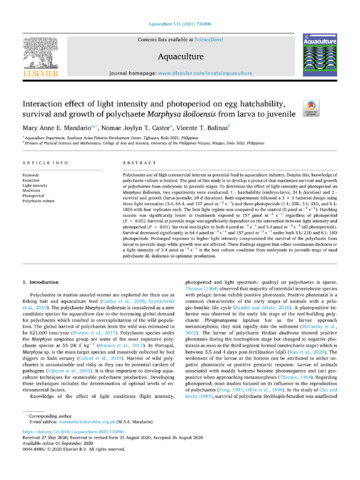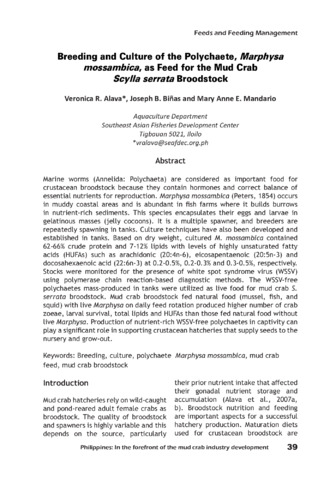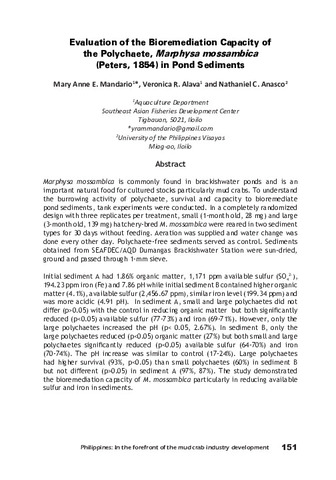Interaction effect of light intensity and photoperiod on egg hatchability, survival and growth of polychaete Marphysa iloiloensis from larva to juvenile
Share
Abstract
Polychaetes are of high commercial interest as potential feed in aquaculture industry. Despite this, knowledge of polychaete culture is limited. The goal of this study is to develop a protocol that maximizes survival and growth of polychaetes from embryonic to juvenile stages. To determine the effect of light intensity and photoperiod on Marphysa iloiloensis, two experiments were conducted; 1 - hatchability (embryo-larva; 24 h duration) and 2 - survival and growth (larva-juvenile; 29 d duration). Both experiments followed a 3 × 3 factorial design using three light intensities (3.4, 64.4, and 157 μmol m−2 s−1) and three photoperiods (1 L: 23D, 3 L: 21D, and 6 L: 18D) with four replicates each. The best light regime was compared to the control (0 μmol m−2 s−1). Hatching success was significantly lower in treatments exposed to 157 μmol m−2 s−1 regardless of photoperiod (P < 0.05). Survival at juvenile stage was significantly dependent on the interaction between light intensity and photoperiod (P < 0.01). Survival was higher in both 0 μmol m−2 s−1 and 3.4 μmol m−2 s−1 (all photoperiods). Survival decreased significantly in 64.4 μmol m−2 s−1 and 157 μmol m−2 s−1 under both 3 L: 21D and 6 L: 18D photoperiods. Prolonged exposure to higher light intensity compromised the survival of the polychaete from larval to juvenile stage while growth was not affected. These findings suggest that either continuous darkness or a light intensity of 3.4 μmol m−2 s−1 is the best culture condition from embryonic to juvenile stage of mud polychaete M. iloiloensis to optimize production.
Keywords
Mudworm Polychaete cultureSuggested Citation
Mandario, M. A., Castor, N. J. T., & Balinas, V. T. (2021). Interaction effect of light intensity and photoperiod on egg hatchability, survival and growth of polychaete Marphysa iloiloensis from larva to juvenile. Aquaculture , 531, 735890. https://doi.org/10.1016/j.aquaculture.2020.735890
Subject
Taxonomic term
Collections
- AQD Journal Articles [1248]
Related items
Showing items related by title, author, creator and subject.
-
Addressing gaps in the culture of pathogen-free polychaetes as feed in shrimp hatcheries
Mandario, Mary Anne E. (Secretariat, Southeast Asian Fisheries Development Center, 2018)One of the factors that contribute to the success of shrimp hatchery operations is the availability of good quality broodstock diets. Polychaetes have been regarded as the best maturation diet for shrimps as they contain ... -
Breeding and culture of the polychaete, Marphysa mossambica, as feed for the mud crab
Alava, Veronica R.; Biñas, Joseph B.; Mandario, Mary Anne (Aquaculture Department, Southeast Asian Fisheries Development Center, 2017)Marine worms (Annelida: Polychaeta) are considered as important food for crustacean broodstock because they contain hormones and correct balance of essential nutrients for reproduction. Marphysa mossambica (Peters, 1854) ... -
Evaluation of the bioremediation capacity of the polychaete, Marphysa mossambica (Peters, 1854) in pond sediments
Mandario, Mary Anne; Alava, Veronica R.; Anasco, Nathaniel C. (Aquaculture Department, Southeast Asian Fisheries Development Center, 2017)Marphysa mossambica is commonly found in brackishwater ponds and is an important natural food for cultured stocks particularly mud crabs. To understand the burrowing activity of polychaete, survival and capacity to ...




